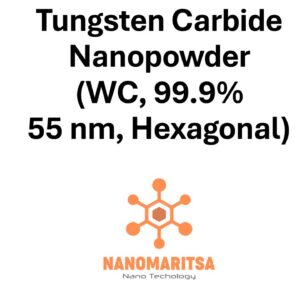Tantalum carbide (TaC) nanopowder, with a purity of 99+% and a particle size of 300 nanometers, is a highly advanced material known for its exceptional hardness, high melting point, and chemical stability. Its cubic crystal structure provides uniform strength and thermal stability, making it indispensable for applications in aerospace, energy, defense, and high-performance manufacturing. This nanopowder combines durability, thermal resistance, and conductivity, enabling its use in cutting-edge technologies.
Composition and Structure
TaC (Tantalum Carbide):
Tantalum carbide is a dense ceramic material composed of tantalum and carbon. Its cubic crystal structure ensures consistent mechanical properties, excellent wear resistance, and high thermal stability, making it suitable for extreme environments.
Purity (99+%):
The 99+% purity ensures minimal impurities, which is crucial for maintaining the reliability and performance of components in aerospace, electronics, and industrial applications.
Particle Size (300 nm):
The 300-nanometer particle size provides a balance between high surface area and structural integrity, enabling optimal dispersion in composites and high-performance coatings.
Properties
Exceptional Hardness and Wear Resistance:
TaC nanopowder is one of the hardest materials known, providing outstanding abrasion and wear resistance. This property makes it ideal for cutting tools, abrasives, and protective coatings in high-stress applications.
High Melting Point:
With a melting point exceeding 3880°C, tantalum carbide exhibits unparalleled thermal stability, making it suitable for high-temperature environments such as aerospace propulsion systems and industrial furnaces.
Chemical Stability:
TaC is highly resistant to oxidation, corrosion, and chemical degradation, ensuring durability in chemically aggressive and high-temperature environments.
Thermal Conductivity:
The material’s excellent thermal conductivity allows efficient heat dissipation, making it an ideal choice for thermal management systems and heat shields.
Electrical Conductivity:
Unlike many ceramics, TaC exhibits good electrical conductivity, making it valuable for applications in electronics and energy storage systems.
Applications
High-Temperature Aerospace Components:
TaC is widely used in aerospace applications, including turbine blades, rocket nozzles, and thermal shields. Its ability to withstand extreme temperatures and stresses makes it a key material in propulsion and high-speed flight systems.
Cutting Tools and Abrasives:
The hardness and wear resistance of TaC make it ideal for cutting tools, drills, and grinding wheels used in industrial manufacturing processes.
Thermal Barrier Coatings:
TaC nanopowder is used to create thermal barrier coatings for components exposed to high temperatures, such as industrial furnaces, power generation equipment, and heat exchangers.
Energy Systems:
TaC is employed in advanced batteries, supercapacitors, and fuel cells, where its conductivity and chemical stability improve efficiency and longevity.
Defense Applications:
Due to its high strength and resistance to extreme conditions, TaC is used in armor systems and other defense-related materials requiring exceptional durability.
Electronics and Semiconductors:
TaC nanopowder is used in microelectronics, particularly in high-performance semiconductors and conductive coatings, where it provides excellent thermal and electrical properties.
Recent Advancements and Research Contributions
University of Manchester, UK:
Researchers are exploring TaC nanopowder for its applications in aerospace and energy systems, focusing on high-temperature and wear-resistant components.
Massachusetts Institute of Technology (MIT), USA:
MIT is investigating the use of TaC in advanced thermal management systems and next-generation propulsion technologies.
Tsinghua University, China:
Tsinghua University is developing TaC-based composites for defense applications and high-temperature coatings.
National University of Singapore (NUS):
NUS scientists are advancing TaC nanopowder for energy storage systems, such as high-efficiency batteries and supercapacitors.
Recent Developments
- Additive Manufacturing: TaC nanopowder is being integrated into 3D printing processes to produce high-performance components for aerospace and industrial applications.
- Hybrid Nanocomposites: Combining TaC with other advanced materials enhances its mechanical and thermal properties, expanding its application scope.
- Eco-Friendly Production: Advances in sustainable synthesis methods are improving the scalability and environmental impact of TaC nanopowder production.
Future Prospects
Tantalum carbide nanopowder (TaC, 99+%, 300 nm, Cubic) is revolutionizing industries requiring materials that can endure extreme conditions. As research progresses, TaC nanopowder is expected to:
- Drive innovations in aerospace propulsion and thermal management systems.
- Enhance the performance and durability of cutting tools and industrial coatings.
- Enable advancements in energy storage technologies and defense materials.
TaC nanopowder exemplifies the potential of nanotechnology to address critical challenges in high-performance applications. Its exceptional properties and versatility make it an indispensable resource for industries seeking durable and efficient solutions for demanding environments.
| Measurement (gr) | 100 grams, 500 grams, 1000 grams |
|---|






